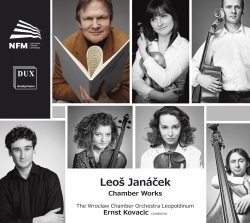|

Support us financially by purchasing this from |
 |
 |
| |
|
|
Leoš JANÁČEK (1854-1928)
Idyll for strings (1878) [26:07]
Suite for two violins, viola, cello and double-bass (1877) [18:41]
Znělka 1. Sonnet for 4 violins (1875) [3:52]
String Quartet No. 1 inspired by Tolstoy’s The Kreutzer Sonata (1923) (arr. string orchestra, Ernst Kovacic) [19:45]
The Wroclaw Chamber Orchestra ‘Leopoldinum’/Ernst Kovacic
rec. 17-19 February, 25-26 March 2013, Concert Hall, Witold Lutosławski Philharmonic, Wrocław, Poland
DUX 0946 [68:46]
This delightful and immensely enjoyable CD can be warmly welcomed as an introduction to the music of the Czech composer Leoš Janáček. It showcases three of his early works as well as an arrangement of the String Quartet No. 1 Kreutzer Sonata for string orchestra.
The earliest work here is Znělka 1, Sonnet for 4 violins, a student composition from 1875. It’s name derives from Znělka (Sonnet) or sonata, a piece for instrumental performance, in contrast to a cantata for vocal performance. It was with this and other student works that Janáček served his apprenticeship, and many fragments from this period were later used in the Suite of 1877. The movements of this orchestral work were originally given baroque titles (Prelude, Allemande) but adverse criticism from some quarters led him to settle for tempo-related titles.
A year later, in 1878, Janáček composed his Idyll for strings, similarly mapping it out to the template of the Suite. The composer had a penchant for this genre, which would crop up later in the Sinfonietta. The Idyll, however, exhibits a more advanced compositional style to its predecessor, with the influence of Dvořák and even hints of Grieg being evident. Indeed, Dvořák attended the first performance in 1878, conducted by the composer.
The last decade of Janáček’s life saw a sudden burst of creativity. In 1917 he met Kamila Stösslová, the wife of an antique dealer, who was thirty-eight years his junior — she was twenty-five at the time. Despite Janáček’s hot pursuit – he was married to Zdenka Schultzova – the affair remained unconsummated. He wrote over 700 hundred letters to her. She did, however, become his muse and was the inspiration for three of his finest operas: Katya Kabanova, The Cunning Little Vixen and The Makropoulos Affair. His passion for Kamila also inspired him to compose the Glagolitic Mass, the Sinfonietta and the two String Quartets.
The composer developed an interest in Russia and its culture, and this passion is reflected in his later works. Tolstoy’s novella ‘The Kreutzer Sonata’ became a fascination for him and an inspiration for an unfinished Piano Trio (1908). In 1923, he composed a String Quartet carrying the title The Kreutzer Sonata utilizing material from the Piano Trio. The Quartet was completed in just a week. Janáček saw parallels with his own situation with Kamila in the Tolstoy novella. The result was a deeply impressionistic work.
Whilst the early works here do not really give a foretaste of the mature composer of the later operas, Sinfonietta and the Glagolitic Mass they are, nevertheless, tuneful and pleasurable. The later Quartet has been arranged, idiomatically and successfully, for string orchestra by the conductor Ernst Kovacic. The work lends itself effectively to such an arrangement, and I see that it has been done before by Richard Tognetti. There are two separate performances on Chandos, one conducted by Tognetti himself. I haven’t heard either to compare.
The Wrocław Chamber Orchestra play with great technical mastery, and deliver captivating and heartfelt performances. The Quartet I would especially single out as ravishingly played with an innate musicality and intuitiveness. The players certainly give of their all. Sound quality is second-to-none.
Stephen Greenbank
 |
 |
|
